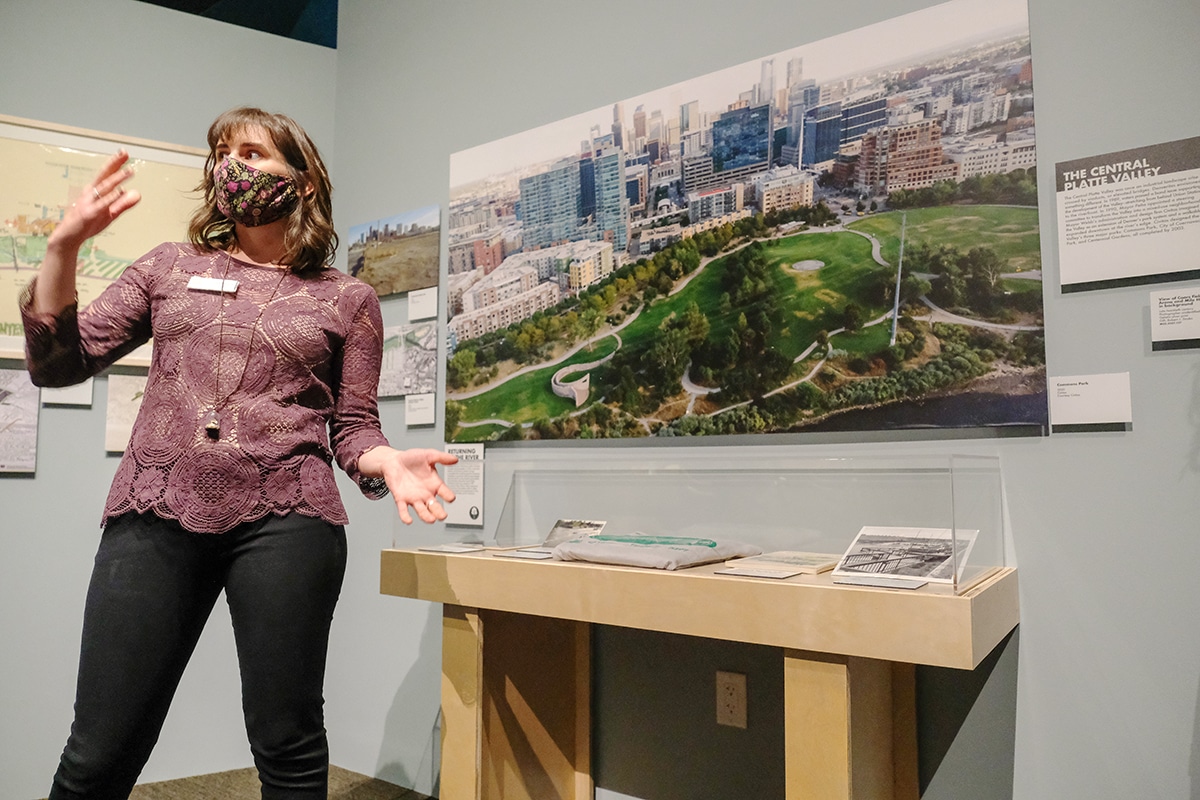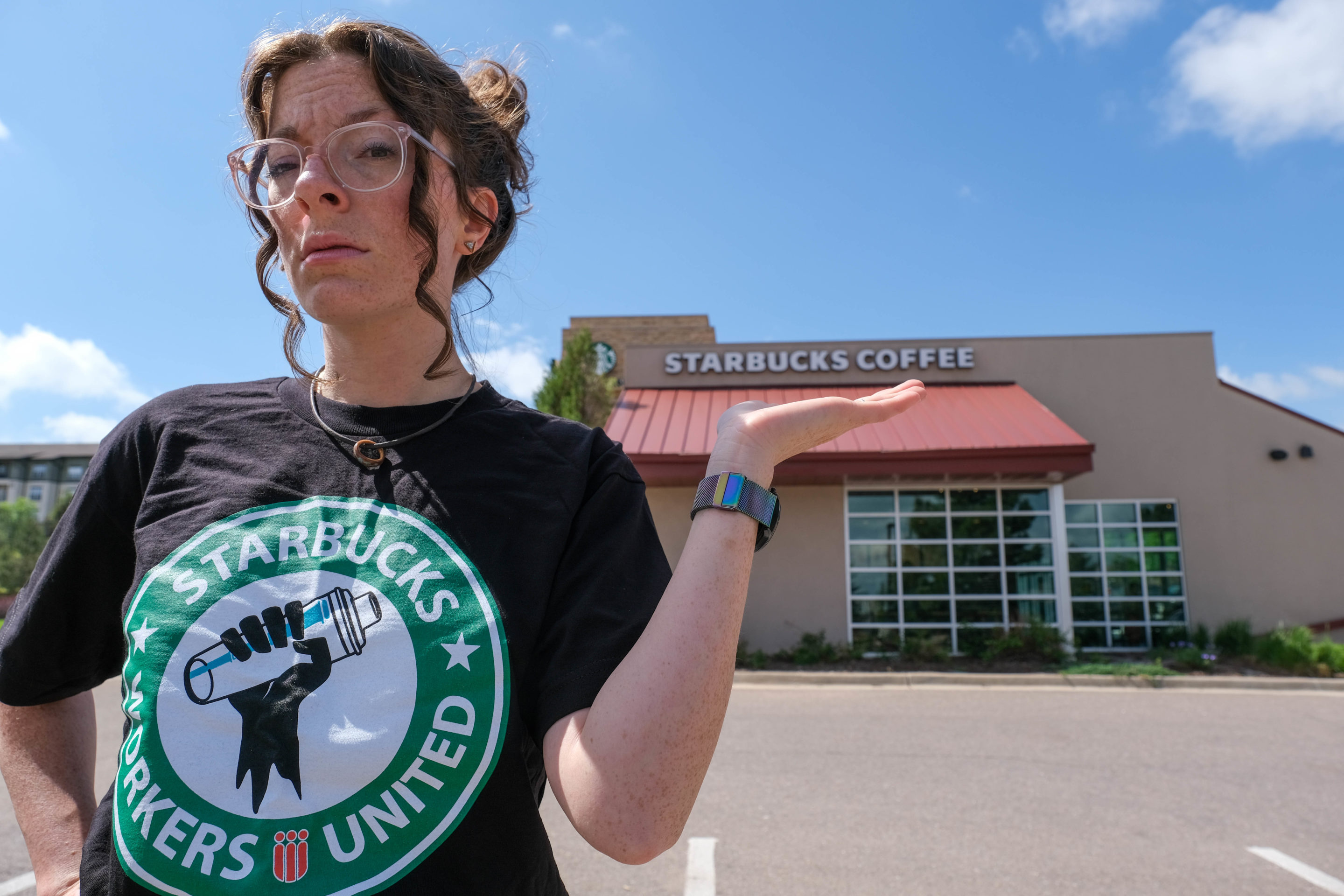//Julie Peterson discusses the Central Park, formerly known as Stapleton, name change while introducing the neighborhood exhibit at the Building Denver: Visions of the Capital City exhibit on May 26. Photo by Esteban Esteban Fernandez | [email protected]
It took several years, several rounds of voting, and pressure from Black Lives Matter 5280, all after eight decades of complacency, to get the residents of Stapleton to change the name of their neighborhood. This struggle was highlighted as part of a new exhibit at History Colorado Center called Building Denver: Visions of the Capital City. It will be on display May 29 through Aug. 31, and chronicles how Denver residents have changed the city over time.
A photo of activists holding a sign saying “Rename St*pleton For All” hangs on the gallery wall. This small photograph may seem innocuous, but its inclusion in the exhibit speaks volumes about its significance. History Colorado chose to highlight this photo, and the story of Central Park, as an example of how Denver residents shape their city through activism.
“We felt it was really important to elevate the voices of everyday residents and their role in changing the city,” said Julie Peterson, public historian and lead researcher on the Central Park portion of Building Denver. “There were a lot of folks calling for the name change in the neighborhood. Then, the momentum of the uprisings for racial justice last summer was really the push that folks needed to make it happen. We thought it was a really relevant example of the ways that everyday people can make a claim on their neighborhood, shape it, and fight for justice on what they want to see in their city.”
In 2019 however, renaming the neighborhood formerly known as Stapleton seemed like an unnecessary change for many residents.
“There was no one reason why residents had resisted the change,” said Geoff Horsfall, a neighborhood resident and member of Central Park United Neighbors. “But, broadly speaking, some struggled to see how changing the name would tangibly impact the underlying issue of systemic racism relative to other actions that the community could conceivably take.”
In 2020, following protests surrounding the murder of George Floyd, the decades-long fight to remove Stapleton’s legacy from Denver finally began receiving media attention. Despite the racist history attached to the name, it took many years of pressure from outside activist groups like Rename St*pleton For All and a national movement to convince residents. Even after they changed it, the nature-based name “Central Park” still erases BIPOC from the landscape.
History Colorado highlighted the name change as part of its exhibition exploring how communities change the spaces they live in to better reflect the people who live there. While it was progress to remove the township’s association to a white supremacist, the quest to remove that association never attracted uniform support from residents.
Benjamin Stapleton, the neighborhood’s namesake, and Colorado governor in 1923-1931 and 1935-1947, had strong ties to the Ku Klux Klan. Those who failed to see the importance of removing his name, or who resisted it entirely, failed to recognize their role in perpetuating white supremacy.
“That’s a very human reaction,” said Liz Stalnaker, a neighborhood resident and board member of Rename St*pleton For All. “And I feel like what I hear in that response—and what we heard in that response—was ‘It doesn’t mean to me what you’re saying it means.’”
According to Stalnaker and Kim Brewer, another board member of Rename St*pleton For All and Central Park resident, many locals cited personal memories and nostalgia connected to the neighborhood when arguing against the change.
Public calls to rename the neighborhood began as early as the 1960s. In the 1990s, the “Rename Stapleton Committee” petitioned city leaders and developers to remove the name “Stapleton” from the area. The city passed responsibility for the name change to the Community Board in the early 2000s, yet the efforts of multiple activist groups failed for another two decades. BLM5280 and Rename St*pleton for All began work on the project in 2015 and 2017, respectively.
But why would someone hold onto the name of a neighborhood, when it clearly promotes a legacy of white supremacy?
“It is really deep, the associations that we have and the sense of community that we have,” Stalnaker said. “And then, when you bring in this dissonance, people are naturally defensive.”
Stalnaker, Brewer, and the other members of Rename St*pleton For All are recognized on the walls of History Colorado because they spent several years working to break down that defensiveness through education and collaboration with the residents of Central Park.
Brewer knows this is just one Band-Aid on a large wound. “We really just had to stop the bleeding,” she said. “People constantly told us if we changed the name, then we are changing the history, we are somehow erasing and pretending that none of what [Benjamin Stapleton] did happened, or none of what he stood for happened. I think that gets very convoluted because people get mixed up about erasing history versus validating and honoring history.”
Both Rename St*pleton For All and Central Park United Neighbors agreed that the murder of George Floyd and BLM protests back in the summer of 2020 finally sparked the desire for change among the community leadership.
“Acknowledging the history of racial oppression, and the efforts of those who have sought to rectify it, was central to the process for identifying the new name,” Horsfall said.
Most of Denver was segregated when Stapleton was governor. People who didn’t pass as white were not allowed to live, work, own property, shop or recreate in large portions of the city. Aside from small ethnic enclaves such as Chinatown, BIPOC names didn’t appear in parts of Denver for most of the 20th century.
“An advisory board was responsible for narrowing the field of 300-plus names submitted by the community to nine options for a community vote,” Horsfall said. “That board included representation from BLM 5280, Rename St*pleton for All and the Indigenous community.”
There were many BIPOC-inclusive suggestions offered by residents but ultimately those were passed up by Stapleton United Neighbors as finalists. Renaming the neighborhood after Justina Ford was suggested due to her status as the first licensed Black female doctor in Denver. Tuskegee Field was another option in honor of the lauded Black airmen. Even a tribute to the Lakota people was offered through “Mitákuye Oyás’iŋ,” or “All are related” in the Lakota language.
“Removal of the name kind of gets you part of the way there,” Stalnaker said. “They’re willing to remove the name [Stapleton] but not willing to put the name of a Black Tuskegee Airman from World War II on the neighborhood. As disappointing as it is for many folks that the name Central Park won over other names, [it is] an accurate gauge of where we are and how much more work there is to be done.”
Enjoyed this story? Help us keep the lights on! Supporting local press ensures the stories you want to read keep coming, become a member for free today! Click here.





This article manages to consider and relate many different perspectives from a polarizing debate. The “Building Denver” exhibition (and the namesake initiative that it’s part of) is eager to do the same. I hope readers will consider visiting the History Colorado Center to experience this exhibition. History Colorado is fortunate to share civic space with Ms. Mayhem!